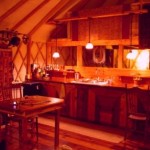And now…a word about Our Sponsors
Yes folks, I was able to spend this past year traveling the country talking with all of YOU about yurts because I have SPONSORS. These are visionary companies who agreed that it was in everyone’s best interests for me to pursue spreading the news and answering your questions about this affordable, accessible, aesthetic and amazing shelter we call the Yurt.
I went to these companies for sponsorships after my book came out because I knew them and respected their products and business practices. (I’ve owned yurts from two of the companies.) And now I’d like to express my heartfelt gratitude to my tour sponsors (drum roll, please): Colorado Yurt Company, Rainier Yurts and Pacific Yurts. Without them it wouldn’t have been remotely possible to do what I did this past year!
All three companies have also participated as sponsors for my yurtinfo.org website, along with GoYurt Shelters. This has enabled me to completely update and redesign the website, making it easier to navigate and adding information that is useful to everyone. For example, I’ve added a couple of excerpts from my book on "How to Buy a Yurt" and "Building Codes", plus new pages on Yurt Workshops, Yurt Financing and Yurt Consulting. Coming soon, to a laptop near you…(hopefully by March at the latest)!
Todd and Monica have a 30′ fabric yurt, but unfortunately they purchased it a couple of years ago from a company that advertises cheap yurts. There were so many problems with their yurt when it arrived (six months late) that it took them an additional six months to put it up. The good side, they said, is that they now know enough about yurts to build their own.
The most amazing thing about Todd and Monica’s yurt is the insulation. In addition to a layer of the usual Reflectix bubble wrap/foil insulation, Monica added a complete inside layer of real felt. The felt, imported from India, came in 7′ rolls. Monica hand stitched the wall sections, with cutouts for the windows, and had a friend machine-stitch 6 large pie-shaped wedges to go on top of the rafters.
The Reflectix layer, which is sandwiched between the felt and the outer covering of the yurt, functions as a
vapor barrier as well as providing additional insulation (and reflecting out the sun’s heat in the summer). Monica pointed out the importance of keeping the felt dry, as it can easily mold or rot if it gets wet.
